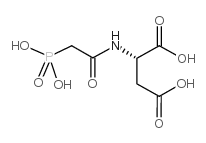51321-79-0
| Name | (2S)-2-[(2-phosphonoacetyl)amino]butanedioic acid |
|---|---|
| Synonyms |
Acide sparfosique [INN-French]
n-(phosphonacetyl)-l-aspartic acid N-(Phosphonoacetyl)-L-aspartic acid N-(phosphonacetyl)-L-aspartate Sparfosic acid Acidum sparfosicum [INN-Latin] Acido sparfosico [INN-Spanish] Phosphonacetyl-L-aspartic acid N-(phosphonoacetyl)-L-aspartate |
| Description | Sparfosic acid is a DNA antimetabolite agent and a potent inhibitor of aspartate transcarbamoyl transferase. Sparfosic acid has anti-tumor activity. Aspartate transcarbamoyl transferase catalyzes the second step of de novo pyrimidine biosynthesis[1][2]. |
|---|---|
| Related Catalog | |
| In Vitro | Sparfosic acid (PALA) causes apoptosis in the resistant Br1 cells[1]. Sparfosic acid (300 µM) shows progressive accumulation of cells in S phase and activation of an apoptotic pathway leading to cell death[1]. Cell Viability Assay[1] Cell Line: Br-l and L-2 cell lines established from metastasis in nude mouse injected with the human tumor cell line MDA-MB-435 Concentration: 300 µM Incubation Time: 12, 24 and 48 hours Result: Cells were predominantly in S phase in both the cell lines, although slightly higher proportion of cells in S phase were noted in L-2 than Brl-3prl cells. Western Blot Analysis[1] Cell Line: Br-l and L-2 cell lines Concentration: 300 µM Incubation Time: 4, 10 and 24 hours Result: There was moderate difference in the level of phosphorylated Rb proteins seen in the two cell types.Marked increase in the amount of cyclin A protein was detected in the L-2 cells undergoing apoptosis with the highest level detected at 10 h post-drug treatment.In contrast, there was no increase in the level of cyclin A seen in the Brl-3prl cells.Cyclin E protein was found elevated in the L-2 cells and Brl-3prl cells compared to their respective controls. |
| References |
| Molecular Formula | C6H10NO8P |
|---|---|
| Molecular Weight | 255.11900 |
| Exact Mass | 255.01400 |
| PSA | 171.04000 |
CHEMICAL IDENTIFICATION
HEALTH HAZARD DATAACUTE TOXICITY DATA
MUTATION DATA
|
